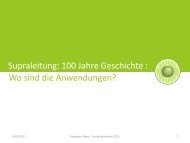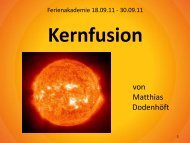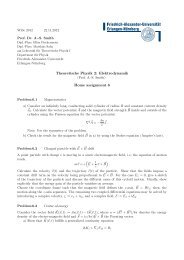Morphology of Experimental and Simulated Turing Patterns
Morphology of Experimental and Simulated Turing Patterns
Morphology of Experimental and Simulated Turing Patterns
Create successful ePaper yourself
Turn your PDF publications into a flip-book with our unique Google optimized e-Paper software.
(a) Inverted hexagonalstate: a = 9.4, b = 0.06(b) Lamellar state: a =12.2, b = 0.3(c) Hexagonal state: a =12, b = 0.37Figure 4.2: Typical patterns for the three different symmetries, which occur in the parameterspace. To obtain more detailed patterns the spatial mesh consists <strong>of</strong> 200 by 200grid points with a spatial discretization <strong>of</strong> ∆ = 1 solved via Euler forward integration with∆t = 0.01 <strong>and</strong> 100000 time-steps.In the following the patterns obtained for u will be analyzed, while patterns in v willnot be treated explicitly. This choice is motivated by the fact that in the experimentthe patterns are obtained in the concentration <strong>of</strong> SI − 3 , which is a function <strong>of</strong> [I− ],i.e. u. Additionally in the LE model there is no qualitative morphological differencebetween patterns in u <strong>and</strong> v. Fig. 4.3 shows both patterns for the hexagonalstate. Both patterns are in phase <strong>and</strong> barely distinguishable. A slightly smootherconcentration gradient is found for v <strong>and</strong> the absolute values for the concentrationare different. As explained in section 2.2.1, this is an important distinction betweenthe LE model an other reaction-diffusion models, such as the Brusselator, where u<strong>and</strong> v are in opposite phase.To illustrate the pattern selection in different regions <strong>of</strong> the parameter space, thenumerical solution has been calculated for certain consecutive values from a = 0.6 −31.8 <strong>and</strong> b = 0.055−1.555. The system was solved on a mesh <strong>of</strong> 200×200 grid pointswith periodic boundary conditions <strong>and</strong> a spatial discretization ∆ = 1 using a FTCSEuler-integration algorithm, as described in section 3.1. The resulting patterns foru after a sufficient number <strong>of</strong> time-steps are shown in Fig. 4.4. The grey-value isproportional to the concentration <strong>of</strong> u. Black corresponds to the global maximum<strong>and</strong> white to the minimum concentration <strong>of</strong> the patterns, i.e. all concentrationsare rescaled to a range from I min to I max . I max can be found for the pattern at(a,b) = (31.8,0.205) <strong>and</strong> I min occurs for the pattern at (a,b,) = (0.6,1.555). Parts<strong>of</strong> the parameter space, where numerical errors or unphysical negative concentrationsoccur, are shaded.Figure 4.5a shows the average concentration 〈u〉 for each <strong>of</strong> the patterns in Fig. 4.4<strong>and</strong> Fig. 4.5b shows the range <strong>of</strong> concentrations for each pattern, i.e. the difference∆u = u max − u min (4.4)for the local minimum <strong>and</strong> maximum concentrations u max <strong>and</strong> u min . As indicated41






